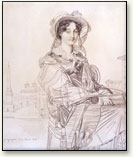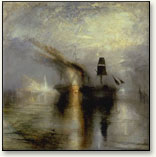Blurred Backgrounds in the 19th Century
In the drawing by Jean-Auguste-Dominique Ingres (1780-1876) at right, the face is drawn with greater detail (higher resolution) than the background. Ingres may have used a small lens (a camera lucida) to help him draw his clients’ faces, and then completed the background scenery from memory. The faces in his drawings show higher resolution and often higher contrast, which focuses attention on the identity of the sitter. Similarly, the imprecise background confirms that the sitter is the focus of the work.
JMW Turner’s painting at left evokes the deep and solemn calm of the funeral of Turner’s old friend and colleague, the painter Sir David Wilkie. Wilkie died on board ship while returning from the Middle East in 1841, and was buried at sea off Gibraltar. A strong focus is the silhouetted black sail, of which Turner declared, “I only wish I had any color to make them blacker.”
The blackness of the sail challenges the traditional laws of aerial perspective, developed by both Northern and Venetian painters, according to which the sail should be less distinct. Turner’s departure from the traditional perspective was his device to emphasize and express grief. The sails are crisp and sharp, but the background of this painting, and many of his seascapes, is blurred and indistinct, creating atmosphere and a sense of motion.

